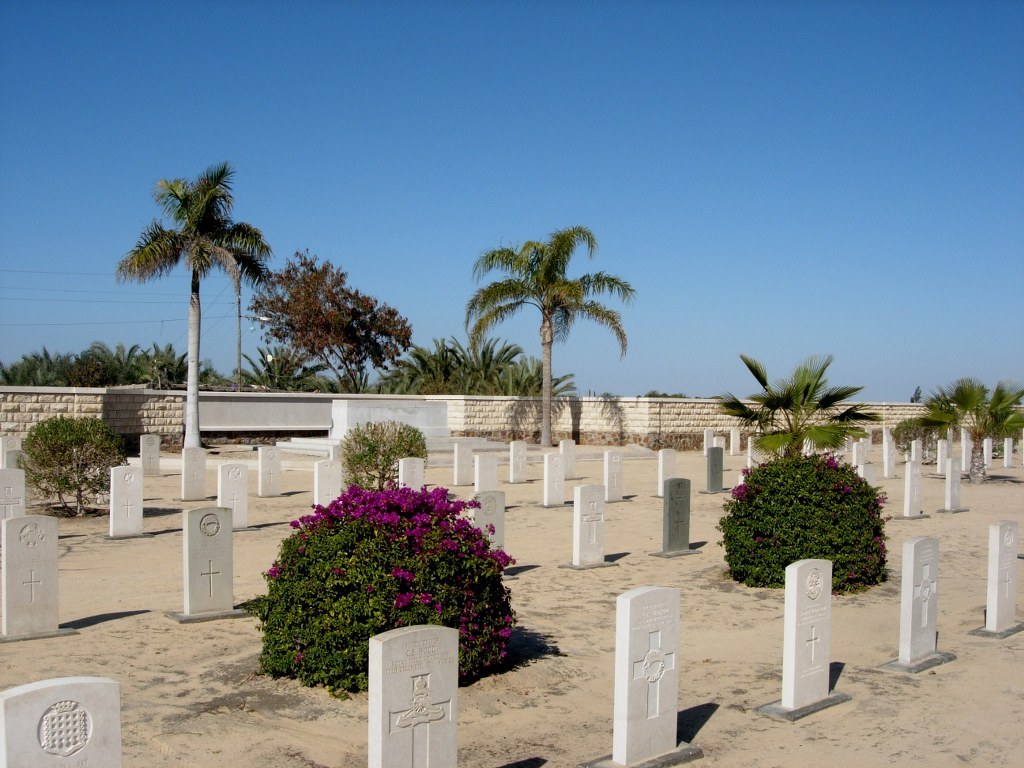Kantara War Memorial Cemetery
- Country Egypt
- Total identified casualties 1942 Find these casualties
- Identified casualties from First & Second World War
- GPS Coordinates Latitude: 30.87194, Longitude: 32.33173
Historical Note
 Within this cemetery stands the Kantara Indian Cemetery Memorial dedicated to the 283 Indian casualties originally buried or commemorated in Kantara Indian Cemetery, which in 1961 was declared unmaintainable. The original memorial had a general inscription, with the names recorded in a printed memorial register. In 2000, these names were added to the memorial.
Within this cemetery stands the Kantara Indian Cemetery Memorial dedicated to the 283 Indian casualties originally buried or commemorated in Kantara Indian Cemetery, which in 1961 was declared unmaintainable. The original memorial had a general inscription, with the names recorded in a printed memorial register. In 2000, these names were added to the memorial.
You can find more information about historical inequalities in commemoration in our Special Committee’s report.
Six years of solitude

KANTARA WAR CEMETERY
Location: Kantara, Egypt Language: Arabic Altitude: 7m Rainfall: 25mm
Temperature: 9°c - 38°c Biggest challenge: Working alone with limited supplies
For six years CWGC gardener Mohamed Abouzied was cut-off from his colleagues. During that time he worked virtually alone. His only company at work were 2,000 war dead buried in the Egyptian desert.
Mohamed is the Commission’s resident gardener at Kantara War Memorial Cemetery. The site sits in the Sinai Peninsula, on the east bank of the Suez Canal. In 2013 a key crossing over the water was shut amid a rise in militant attacks.

Mohamed has worked for CWGC in Egypt for over 20 years.
Access for people coming in from elsewhere in Egypt was tough. For Mohamed, as a citizen of the region, he was able to stay put in the live-in accommodation at our cemetery – a setup that’s not uncommon for remote war cemeteries.
Regular phone contact with his managers was still possible and once they were assured it was going to be safe for him to stay on, they agreed to his continued work.
And that’s exactly what Mohamed did. Quietly, and without ceremony, he continued his job. He did minor repair work, swept away wind-blown debris, re-levelled the sand and tended to the few plants that can survive the desert conditions.

Kantara War Memorial Cemetery contains nearly 2,000 war dead from more than 10 nations.
He is one of many unsung heroes at the Commission. Within his care were the final resting places of war dead from more than 10 nations – allies and enemies from both World Wars. But none of them were forgotten.
While no one else could, he was there to remember and to tend.
Thankfully, things have since improved. In summer 2019, a new tunnel under the Suez Canal was opened, making access simple once more. Improved tools and supplies could be brought in and Mohamed received his first visitor in years: his manager, Baghdady Rashed.
And when Baghdady arrived, the site looked as if there had never been any problems at all.

The cemetery planting is carefully picked to suit the hot and dry local conditions.
Location information
Kantara War Memorial Cemetery is situated at Kantara East on the eastern side of the Suez Canal, 160 kilometres north-east of Cairo and 50 kilometres south of Port Said.
Access to Kantara East is via vehicular or small passenger ferry from Kantara West. Kantara East is 30 kilometres north of Ismailia on the main Ismailia-Port Said road. The cemetery is 3 kilometres by road from the ferry, on the northern outskirts of the village.
It is now possible to access the Cemetery crossing the Suez Canal Bridge. Once on the Sinai side of the bridge follow (north) the signs for Kantara. The Cemetery is located on the right side of the road (within 70 metres) as you enter the town of Kantara.
Visiting information
Visitors are advised to consult the Foreign Commonwealth Office travel advice before considering a visit to the region due to the current unrest. For up-to-date information visit www.gov.uk/foreign-travel-advice
Opening times:
Saturday to Thursday: 7.00am to 2.30pm.
Friday: closed.
Wheelchair access to the cemetery is possible via the main entrance of the cemetery. For further information and enquiries please contact enquiries@cwgc.org
Please note that some of the rows in this cemetery contain later, additional burials. The grave numbers in these particular rows may not therefore relate to the actual headstone numbers on the ground, for example Grave 1a = headstone 1, Grave 1b = headstone 2 and so on.
History information
In the early part of the First World War, Kantara was an important point in the defence of Suez against Turkish attacks and marked the starting point of the new railway east towards Sinai and Palestine, begun in January 1916. Kantara developed into a major base and hospital centre and the cemetery was begun in February 1916 for burials from the various hospitals, continuing in use until late 1920. After the Armistice, the cemetery was more than doubled in size when graves were brought in from other cemeteries and desert battlefields, notably those at Rumani, Qatia, El Arish and Rafa.
The Second World War again saw Kantara as a hospital centre. No 1 General Hospital was there from July 1941 to December 1945 and two others, Nos 41 and 92, were there in turn for varying periods. One of the major allied medical units in the area, No 8 Polish General Hospital, adjoined the war cemetery.
KANTARA WAR MEMORIAL CEMETERY now contains 1,562 Commonwealth burials of the First World War and 110 from the Second World War. There are also 341 war graves of other nationalities in the cemetery, many of them made from the Polish hospital and concentrated in a distinct Polish extension.
Near the entrance to the cemetery is the KANTARA MEMORIAL, bearing the names of 16 New Zealand servicemen of the First World War who died in actions at Rumani and Rafa, and who have no known grave.
In 1961, nearby Kantara Indian Cemetery became inaccessible and it was decided that the 283 First World War servicemen buried there should instead be commemorated at Kantara War Memorial Cemetery. Panels bearing the names of the dead were affixed to the wall of the cemetery behind the Stone of Remembrance, forming the KANTARA INDIAN CEMETERY MEMORIAL.



